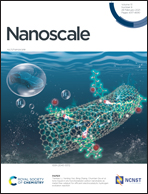Magnetic-field-induced self-assembly of FeCo/CoFe2O4 core/shell nanoparticles with tunable collective magnetic properties†
Abstract
Self-assembly of nanoparticles into ordered patterns is a novel approach to build up new consolidated materials with desired collective physical properties. Herein, nanoparticle assemblies of composition-modulated bimagnetic nanoparticles have been produced via slow evaporation of their colloidal suspension in the absence or presence of magnetic fields. The assemblies obtained in the presence of the magnetic fields exhibit oriented nanoparticle chains in face-centered cubic superlattice structures, compared with the hexagonal closed-packed superlattice obtained without the magnetic field. The oriented structure has an alignment of the easy magnetization axis along the chains. This alignment leads to enhanced intra-superlattice interactions. As a result, the field-induced assembly displays collective magnetic properties with significantly enhanced magnetic anisotropy, remanent magnetization and coercivity. It is also found that the bimagnetic FeCo/CoFe2O4 core/shell nanostructure enhances the intra-particle interaction and thus is beneficial for the growth of oriented assembly of nanoparticles. Furthermore, the collective magnetic behavior is evidenced by the observation of a superferromagnetic-like magnetization relaxation in the ac-susceptibility curves.

- This article is part of the themed collection: 2021 Nanoscale HOT Article Collection


 Please wait while we load your content...
Please wait while we load your content...